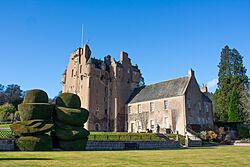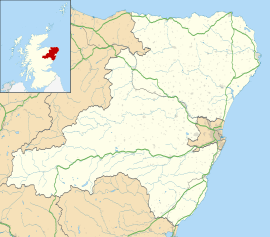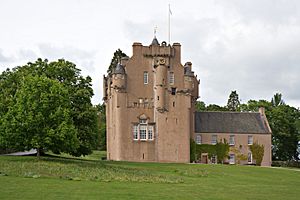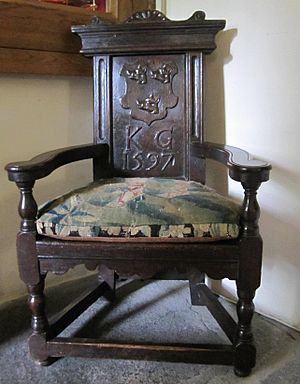Crathes Castle facts for kids
Quick facts for kids Crathes Castle |
|
|---|---|
| Part of Aberdeenshire | |
| Near Banchory, Aberdeenshire, Scotland | |
 |
|
| Coordinates | 57°03′41″N 2°26′24″W / 57.061483°N 2.439917°W |
| Type | Castle |
| Site history | |
| Built | 16th century |
Crathes Castle (pronounced KRATH-iss) is a fairytale-like castle built in the 16th century. You can find it near the town of Banchory in Aberdeenshire, Scotland.
This beautiful castle was built by the Burnetts of Leys family. They owned it for almost 400 years! Today, the castle and its amazing grounds are cared for by the National Trust for Scotland. This means they are open for everyone to visit and explore.
Contents
The Story of Crathes Castle
The history of Crathes Castle goes back hundreds of years. The land it sits on was a gift to the Burnett of Leys family from the famous King Robert the Bruce in 1323.
An Island Fort
Before building the stone castle we see today, the family had a different kind of home. In the 14th and 15th centuries, they built a wooden fortress on a man-made island in a nearby bog. This type of fort, called a crannog, was a smart way to stay safe in the Late Middle Ages.
Building the Tower House
Work on the current stone tower house began in 1553. However, building had to stop and start several times. This was because of political troubles in Scotland during the time of Mary, Queen of Scots.
The castle was finally finished in 1596 by Alexander Burnett of Leys. Later, in the 18th century, a new wing was added to the castle.
A New Look
In 1877, Sir Robert Burnett made big changes to the Great Hall. He added dark oak panels and fancy gilded leather to the walls. He did this to make the castle feel even older and more historic for his American wife, Matilda, and their guests.
During this work, builders spotted something amazing. Hidden under plaster were beautifully painted ceilings from the 1600s! They were fully uncovered in 1913.
The Burnett family lived in the castle until 1951. Then, Sir James Burnett gave the castle to the National Trust for Scotland so it could be preserved for the future.
The 1966 Fire
Sadly, a fire broke out in the castle on January 6, 1966. It caused a lot of damage, especially to the wing named after Queen Anne.
After the fire, experts decided how to repair the castle. They rebuilt the Queen Anne wing to its original two-story height. However, a wing that had been added in the Victorian era was torn down completely.
Inside the Castle
Stepping inside Crathes Castle is like traveling back in time. The castle is filled with amazing things to see.
Painted Ceilings and Old Furniture
One of the most special features of the castle is its original painted ceilings. These colorful works of art from the Jacobean era decorate several rooms. You can see them in the Chamber of the Muses and the Chamber of Nine Worthies.
The castle also has a large collection of family portraits. You can even see furniture that is over 400 years old! This includes a beautifully carved bed and two special chairs from 1597. The chairs are carved with the initials of the owners who lived there long ago.
Gardens and Grounds
The castle is surrounded by a huge estate covering 530 acres. This includes woodlands, fields, and a stunning four-acre walled garden.
The walled garden is a must-see. It has gravel paths that lead you through areas filled with beautiful plants and flowers. Ancient hedges made of Irish yew trees, planted in 1702, divide the garden into eight different themed areas. There is even a grass court for playing croquet.
The castle and its grounds are open to visitors all year. There is a visitor center, a tea shop, and a car park.
The World's Oldest Calendar
In 2004, archaeologists made an incredible discovery on the castle grounds. They found a series of 12 pits that are believed to be about 10,000 years old!
Scientists studied the pits and in 2013, they announced what they had found. The pits form a lunar calendar, which tracks the phases of the Moon. It dates from around 8000 BC, making it the oldest known calendar in the world. It is thousands of years older than other ancient time-measuring sites in Mesopotamia.
This amazing Stone Age site was first spotted from the air. Experts saw strange marks in the crops growing in a place called Warren Field and decided to investigate.
See also
 In Spanish: Castillo de Crathes para niños
In Spanish: Castillo de Crathes para niños





